 |
Movie Reviews
The Matrix, The Matrix Reloaded &
The Matrix Revolution
The Matrix trilogy reviewed by Atila S. Guimarães
To analyze the three Matrix movies and give my opinion, I will divide the subject into several parts. It is not only a question of method to expose my thoughts more easily, but also an attempt to describe the reactions of an average reader to the trilogy.
I will divide the subject into four parts, answering the following questions:
• First, what are the impressions successively formed in the viewer watching this series?
• Second, for a more reflective viewer who tries to enter the philosophical underpinnings of the series, what kind of thinking does it suggest?
• Third, following the trilogy’s drama, what influence does the story line have on a typical viewer?
• Fourth, what remains in the mind of the viewer after watching the trilogy?
1. The impressions
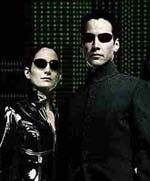
The pallid faces and sunglasses suggest drug users or the occult |
One of my first impressions watching The Matrix was the contrast between the strange pallor of the faces of the main characters, Neo and Trinity, and their black clothing. It doesn’t seem normal to me for a person to be so pale.
I have seen this kind of pasty complexion on sick persons, drugs addicts, or followers of occult sects, but not on normal healthy people. It is also curious that the main characters wear dark sunglasses almost constantly, even at night or indoors. I was told that some drug addicts cannot bear the light, so they wear sunglasses all the time. This gave me the impression that The Matrix heroes have a drugged or occult appearance.
The impression of something occult is confirmed when Thomas Anderson, a computer programmer living a disjointed existence in the world, is initiated into a secret group and adopts the name of Neo. After this initiation he starts to wear a long black cloak very similar to a cassock.
Did he become a priest of some new religion? No answer. Just an insinuation that he has a sacerdotal role to play in some important sacrifice that will be offered to some strange god. Again, we aren’t told who this god is, but it is surely it does not seem to be the God we adore in the Catholic Church.
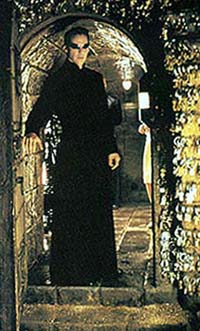
A long black cloak very similar to a cassock... |
The impression of an occult message magnifies with Morpheus’ appearance. Soon it is clear that this man, also in black and wearing his around-the-clock sunglasses, is assuming the role of a kind of John the Baptist, a precursor to a “messiah” who will end the war between the establishment and the group that revolted against it. Like the Baptist, he preaches about the coming the new savior, whom he believes is Neo.
The mystical inspiration for this “redemption” comes from an Oracle, a woman who gave me the impression of a voodoo witch doctor. This woman is surrounded by a Uri Geller brand of paranormal children, one a small Buddhist bending and straightening spoons, others in trances playing games of levitating objects.
As the movie progresses one realizes that almost all the ambiences inhabited by the partisans of the “good” cause are sordid and squalid. Morpheus’ ship is a heap of scrap metal, a filthy pile of junk. Their city – Zion – supposedly a symbol of the “civilization” to be restored, gives the impression of a dilapidated factory transformed into a habitat for beggars. Zion’s inhabitants normally appear in worn and shabby unisex shirts that never seem to be changed and laundered. Again, almost everything is sordid, worn, and dirty.
A detail worthy of attention: Zion is placed in the center of the earth, the site of Hell, according to traditional thinking of the Church. Access to the city Zion runs through a network of large, badly dug tunnels that begin in the sewers of the great cities. I have read in different sources that in some mountains of Tibet, in several caves of Brazil, and at places in the North Pole, there are secret tunnels for communication straight with Hell. It is said they are used by Tibetan monks, UFO insiders, or other initiated persons to have direct access to the Devil. The tunnels leading to Zion in The Matrix series led me to question whether they had an analogous goal.
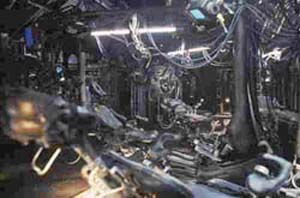
Morpheus’ ship is a heap of scrap metal, a filthy pile of junk
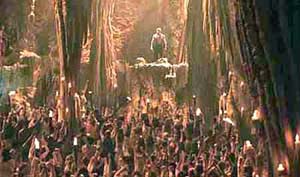
Zion, an enormous cave placed in the center of the earth, like Hell. The inhabitants gather for a tribal feast: a sexual orgy.
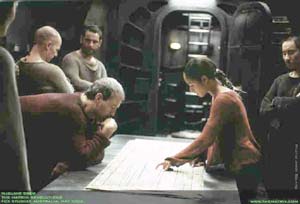
Dirty and unchanged shirts
are worn by both sexes in the rebel group |
Both in Morpheus’ ship and in Zion, the life of the people is something that is not just communist, but trans-communist. I would say tribalist. No more state, no more laws, the inhabitants bound together in a social unit only by the same revolt against the establishment and the primitive gregarious instinct of Indians. No morals, but free love. A feast, a virtual sexual orgy, takes place after a grand tribal meeting so that all the Zion inhabitants will be “well prepared” for the coming war. Wildly gyrating semi-naked bodies dancing to a raw and savage rock music are depicted onscreen for many minutes – including an erotic scene with the main actor and actress.
The council of elders that directs the city is inspired, as in a tribe, by a witchdoctor, the Oracle. This Zionic way of life and government, however, is presented to the average viewer as something good, a kind of paragon of freedom for man, a system worthy of admiration and praise. Even more, as something messianic that would be the model for tomorrow.
On the contrary, the normal people who live in the world – we are shown an undefined big city with airs of New York – are presented as bad. These people are depicted wearing decent clothing, suits, shirts and ties, going to work, carrying out their lives in an orderly fashion, such as we see around us today. This city and its people are presented as bad because they respect hierarchy and follow the rules of society. It is a world that still distinguishes between order and disorder, truth and error, good and evil, beauty and ugliness. Such order, hierarchy, and distinctions are all rejected by the rebels of Zion, who condemn and deny such criteria as bad.
The implicit criticism of the present day society is clear: normal people like you and me in our everyday lives of work, family and religion would have been manipulated by some powerful mind to think what we are thinking.
In conclusion, the general impression produced by The Matrix series is this: what is normally considered decent, clean, and good is presented as something bad and artificial. On the other hand, what is revolted, dirty, ugly, disordered, anarchist, without morals and even with Satanist hues is presented as the good.

Paranormal children bending spoons,
and levitating objects

|
Until now, I have just described some first impressions of a viewer. Let me go a step further.
Where do these impressions lead us?
I suspect that we are dealing with a new version of Theosophism. Theosophism preaches that there are two gods, the white god and the black god. According to its doctrine, there was a fight between these gods at the beginning of time. One won and called himself the white god, or simply God – He is the God of the Catholic doctrine, according to Theosophism. He also named the defeated one the black god, or Devil. Theosophism says that this first struggle ended not with a defeat of the evil god, but the good one. The defeated god – the Devil – is supposedly the good one. Vice-versa, the white god – the God recognized by the Catholic Religion – is really the bad one. So, it strives to depose God, and to free and enthrone the Devil in the government of creation.
The practical consequence of this doctrine is the rejection of everything that has hierarchy, order, law, morals and restraints, as well as everything that is truth, good, and beautiful. These are considered bad things because in reality they are reflections of the “white god.” He would have imposed these principles on us in order to keep us fooled and enslaved to His system. On the contrary, everything that is revolted, anarchical, chaotic, and morally libertarian is a reflection of the “black god” and should be promoted. Man would be truly free when the right god, the black god, would be victorious over creation. The final goal of Theosophism, as well as the Matrix Revolution, would be to destroy the Matrix of the “white god” and install the reign of the “black god.”
Thus, as far as impressions are concerned – and a movie is mostly an ensemble of impressions – it seems to me that The Matrix series is spreading an implicit theosophist message worldwide.
2. The thoughts
For those who go deeper than the level of impressions and consider the philosophical thinking this series suggests, the message is one of complete relativism right from the beginning.
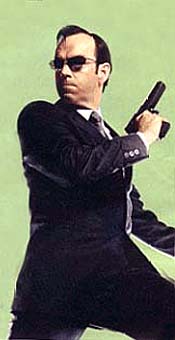
Agent Smith is the protector of the establishment, The Matrix |
The first philosophical thesis spelled out by Morpheus in his initial interview with Neo and threaded throughout the series, is that everything that you see, hear, smell, taste, or touch is not real, but rather an illusion formed in your mind as the product of rules imposed on you by some powerful mind who controls the establishment. This denial of the surrounding evidence – the ground is not the ground, the ball is not the ball, etc. – is a denial of the very essence (ens) of the things we see, hear, smell, etc. By extension it is a denial of human nature (esse), as well as a denial of the individuality of each human being (unum). Without these three transcendental elements, man cannot think, live, and reach his end, i.e., to know, love and serve the Absolute, which is God.
The second philosophical thesis that appears in the series is that a person can bi-locate by strapping himself into a kind of dentist chair and plugging a cable into the back of his head. This would allow the person to be transported through space to any part of the world. To return, it would be enough to answer a phone call made by the operator who plugged him. Let me seriously analyze this stupidity. Ubiquity – the simultaneous presence of a person in two different places – cannot be realized by human nature as a rule. To suppose that you are not a unique individual, but rather that you can have an identical copy of your body and soul elsewhere, is a clear denial that you are only one being (unum). It also denies that you are yourself and nobody else (aliquid). This absurdity also denies the principle of identity, which states that a being is what it is, as well as the principle of causality, because while a telephone line can transmit a reproduction of your voice, it cannot duplicate your body and soul. It is an effect disproportionate to the alleged cause.
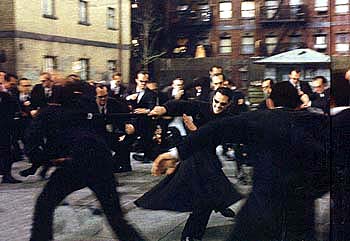
Hundreds of cloned-Smiths fight to destroy the new "messiah" |
The third philosophical thesis is implicit in the cloning process, the copying of himself that agent Smith does by simply touching other persons, impressing himself onto them. He keeps copying and re-copying himself in such a way that at the end of the series you can see hundreds of Smith who gather together to destroy the hero, Neo. This perfect cloning also contradicts the transcendental elements of unum and aliquid. In the movie, the cloned person can become Smith, but still remain himself and returns to his original body and soul when Smith stops using it. This goes against the principle of contradiction, which states a person cannot be and not be only one thing at the same time.
Without these transcendental elements – ens, esse, unum, aliquid – and without the mentioned first principles of human reason that come from them, there is no honest thinking or philosophy.
Therefore, in terms of sane thinking, The Matrix series should be described as a lunacy. It works in the mind like a drug to deny what is evident, to upset and overturn the fundamental principles of being, to make you think that the reality is not what it is, but what you want it to be. Regarding philosophical principles, this series can only be harmful for those who watch it, principally for youth and children.
Objection
One could object that many modern philosophers have adopted similar theses denying the visible reality.
I agree, they do. But this does not make the authors of this series less crazy than they. Many of the critiques of modern philosophy can be applied to the thinking that is behind this series.
But there is more. In The Matrix trilogy the madness goes a step further than in the extravagant Pantheism that inspires most of the modern philosophers. Such philosophers defend that the world is an abstraction of your mind, a product of your will or sentiments, but they still admit that your “you” is the base of the process. In The Matrix series, there is no longer an “I” or a “you”. You think that the reality is so-and-so because someone else destroyed your individuality and took over your mind and will. Since you lost your mind and will, you became a slave in the very essence of your being. It is an accusation that you are a robot controlled by another mind, or a zombie possessed by another spirit. This conception of the enslavement of the human being goes much further than German Idealism, Phenomenology or Existentialism.
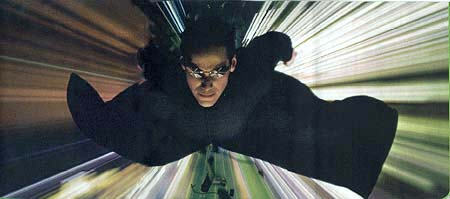
After delivering his will to a higher spirit,
Neo receives the preternatural power to fly |
How can one be freed from this possession, this slavery? The solution is, according to The Matrix series, to be voluntarily possessed by another spirit. When Neo chooses to assume the spirit that inspires Zion’s inhabitants, he receives in exchange the gifts of ubiquity and wisdom – the possibility of knowing the things he needs by telepathic transmission. When he acknowledges that he is the most important member of the movement, the “messiah,” he receives the gifts of flying and invulnerability to bullets. He successively makes new offerings of his will to this spirit and receives more and more power; he is able to resurrect the dead, confront the Architect, and, at last, to face the Source itself.
With this, the series sends a message to the viewer: By being possessed by a superior spirit, you can counter-attack the enemies with the preternatural forces of the higher power that possesses you. This voluntary delivering of one’s will to preternatural forces capable of destroying the present day order seems to me the philosophical keystone of The Matrix’ message. As one can see, it is a very dangerous message, especially for so many confused viewers of our days.
3. The fable
The story line of the series can be summarized as follows:
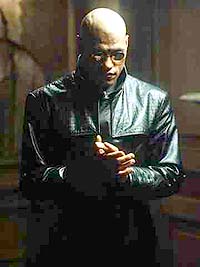
Morpheus is the initiated one who discovers the new "messiah."
He has an indisbutably occult air... |
Sometime at the end of the 20th century the world had been destroyed during a cataclysmic war between computers and their human creators. The computers won, and keep the human race alive in pods, cocoon-like shells, their bodies providing bio-electric power for the machines. Their minds are plugged into the Matrix, a virtual-reality computer program hard-wired into humans to make them think they are living normal lives in the world. But all is an illusion created by the mind that controls the machines to enslave man.
A few rebels have escaped the Matrix and started a revolution to destroy it and deliver humanity from this “evil.” But they are weak and constantly hunted down and defeated by the agents of the Matrix. Burrowed in their underground city, Zion, the hopes of this ragged remnant lie in finding the One, the “messiah” prophesized to come and lead them in a war of liberation to save Zion and destroy the Matrix. The believers are oriented and sustained in their hopes by the Oracle, a paranormal mysterious woman who takes their part against the agents of the Matrix.
Thomas Anderson enters this pictures as a mediocre computer operator who was discovered by Morpheus as a possible “messiah.” Entering the new Zionic life he is protected by Morpheus and Trinity, both with paranormal gifts.
By the end of the first movie, Neo realizes that he is the “messiah.” As the second comes to a close, he meets with the Architect, the mind who created the Matrix, a man-god. The system was created to be perfect, the Architect explains, but failed because a small percentage of humans rejected the system, causing an anomaly that threaten the stability of the Matrix.
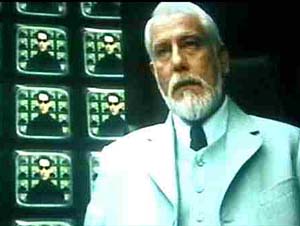
The Architect is the mind that created the Matrix, our visible world. A man-god who represents the evil that the hero wants to destroy. |
As in The Matrix trilogy that supposes the Architect as the bad mind who made creation, for various Gnostic systems, creation as it exists is bad, the fruit of the bad mind of its creator. The sect of the Adepts of the Mother (2nd century) called this bad mind Jaldabaoth; the Valentinians (2nd century) called it the Demiurge; the Barbelo Gnostics (3rd century) called it the Protoarchon; the Archontics (4th century) named him Sabaoth, and so on. Almost all them identified this bad mind with the God of the Old Covenant. The Gnostic sect of the Sethians (so-called followers of Seth, the first son of Adam) consider the created Cosmos as a matrix, like the present day film trilogy.
In the interview with Neo, the Architect also reveals that the Oracle is the mother of the Matrix. Therefore, a Feminine divinity, a woman-god appears in the picture: the Oracle, who protects Neo and Zion and is in conflict with the Masculine divinity, the Architect. So we have a “good” divine power struggling against the established order.
Similarly to this conception of The Matrix, many Gnostic sects – the five ones I quoted above, for instance – held that an Eternal Feminine principle introduced an element of good into this bad creation that would permit the people to free themselves and finally defeat the Masculine principle. Among other things, it was the Feminine principle that inspired the serpent when it invited Adam and Eve to revolt against the Creator. From this came the Gnostic sect of the Ophites or Naasens (adorers of the serpent; ophideon and naas, respectively Greek and Hebrew for serpent) that also has similarities with The Matrix.
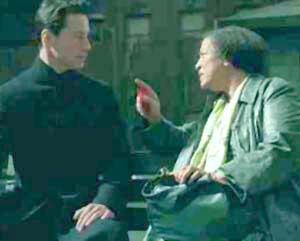
The Oracle is a woman with a voodoo air who represents the Feminine divinity. She protects Neo and Zion |
According to the Gnostic systems, the redemption of this created order will be only possible when an Éon (an emanation of the divinity, in Greek) will come to reveal a new knowledge (gnosis, in Greek). This knowledge will reveal how the present order is bad and how man can be freed from it. This Éon is presented in The Matrix trilogy lightly disguised under the names of Neo and the One, two anagrams for Éon. That is to say, he is the hero of the series. Both in the Gnostic myths as well as in The Matrix series, the Éon is protected by the Feminine.
At the climax of the series (third movie), the principle supporter of the Architect, Smith, imprisons the Oracle, cloning her into another Smith. Only one hope remains for Neo and Zion, who can no longer count on her assistance. He must go straight to the Source, the god who controls everything, including the Architect and the Oracle. The Source is inaccessible, but after great efforts and sufferings, and with the indispensable help of Trinity, who dies for him, finally Neo stands before the Source and talks to this powerful spirit. He proposes a peace to the Source, who accepts it with the condition that Neo defeat agent Smith.
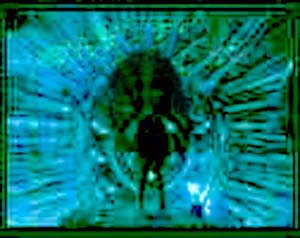
The series reaches its apex with the confrontation between the hero and the Source, the first principle that controls everything |
So Neo faces off for a final dramatic match with hundreds of cloned-agents-Smith and at last manages to conquer one of them. Doing this the power of the agent is broken and all the Smith copies explode. It results the Smith who was defeated by Neo was the Oracle imprisoned under the appearance of Smith. Still a trick of the Feminine to give an advantage to Neo. But as a result of his extraordinary last effort, Neo also lays on the ground senseless. Is he dead? Has he only fainted? No clear answer is offered.
Therefore, the Feminine, the Oracle, ends by deceiving the Masculine, the Architect, in order to give the victory to Neo and Zion. Part of the prophecy is fulfilled, and a time of peace begins. The series ends with a conversation between the Architect and Oracle. He asks her how long the peace will last. No answer.
The door is open for a sequence of the drama, a next movie, or a next series in which Neo would return and continue his mission, that is, destroy the “bad” world, the Matrix and establish the kingdom of Zion over its ruins.
The general line of The Matrix trilogy is very similar to the Gnostic fables. It seems to me an up-to-date-version of old fables translated into computer language.
4. Conclusion
It is my opinion that the three different showers of data – the impressions, the thinking and the Gnostic fable – that inundate the viewer of The Matrix series tend to influence him in the many negative ways I described. If he is not well-prepared and vigilant, he will be contaminated by some poison. I hope I have given him some antidotes to defend himself. It is the goal of this review.

Posted on June 22, 2004
|
Movie Reviews | Home | Books | CDs | Search | Contact Us

© 2002- Tradition in Action, Inc. All Rights Reserved
|
 |
|